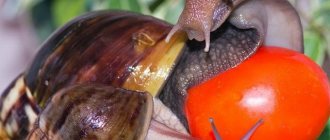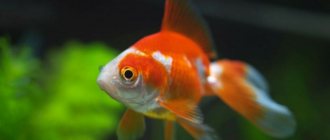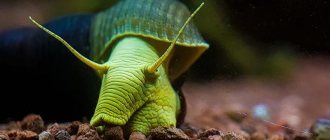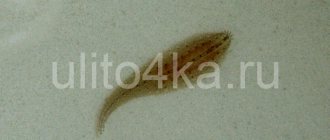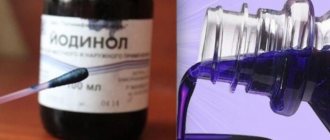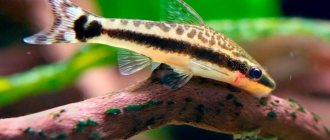Aquarium. Fish, plants and... Of course, snails. Snails often appear in an aquarium on their own. Well, of course, not entirely ourselves. Simply by buying another aquarium plant or soil, we, without noticing it ourselves, willy-nilly populate our aquarium with these inhabitants. You can let the life of snails acquired in this way take their course, but I would recommend that you familiarize yourself with the benefits or harm snails can cause to an aquarium, their maintenance, feeding and reproduction, as well as some of the most common species. Moreover, you don’t have to go far, since all the necessary and comprehensive information is presented below.
Description of snails
The body of the mollusk has a protective calcareous shell, usually spiral-shaped. The mollusk shell also serves as a shelter into which the snails hide when danger approaches.
The weight of the shell is about 30-40 percent of the total weight of the mollusk and does not cause any inconvenience to the snails. The color, structure and geometry of the shell makes it possible to distinguish representatives of one species or another. The lifespan of snails in an aquarium is about two to three years.
What are nematodes?
In nature, there are up to 24 thousand species of nematodes. These are long worms with a round, smooth body. Their length ranges from 80 microns to 8.4 m. Females are usually larger, and can be barrel- or lemon-shaped. The head shows signs of triradiate symmetry.
Nematodes are predominantly heterosexual, but hermaphrodites are also found. To reproduce, worms lay eggs. However, scientists have also discovered viviparous species of these fauna representatives.
Conditions for keeping snails in an aquarium
The water should not be too soft, otherwise the snail shells will begin to collapse. The calcium content in water should be sufficient.
Most snails require aeration and filtration of the water. The temperature regime is suitable for most tropical fish species at 24-25 degrees Celsius. Higher temperatures in the aquarium shorten the lifespan. By the way, snails usually live in an aquarium for a couple of years, no more.
Attention! It is worth knowing and remembering that copper is harmful to all shellfish.
Types of snail breathing
Snails have one of two types of breathing: pulmonary or gill.
The pulmonary type of breathing requires the snail to periodically crawl above the surface of the water. The periods of atmospheric air intake for different snails differ depending on the composition of the mollusk’s blood.
The gill type of respiration allows the snail to consume exclusively oxygen dissolved in water. Snails with this type of breathing, as a rule, leave the water only if unfavorable conditions arise.
Direct
If we compare the amount of oxygen consumed between fish and snails, then mollusks consume less oxygen than small fish, so there is no need to worry about oxygen starvation.
Enemies of snails in the aquarium
The enemies of snails, as strange as it may sound, can be fish as large as cichlids, which have a powerful jaw apparatus.
Also harmful to snails are the so-called snail leeches, which can be brought from a natural body of water and can completely destroy the snail population in an aquarium. However, snail leeches are completely safe for fish.
Are snails useful in an aquarium?
Snails in an aquarium can bring both benefits and some harm or inconvenience.
Benefit:
1. Snails, along with shrimp and some fish such as mollies, are aquarium orderlies.
The sanitary function of snails is to clean the aquarium from the remains of the aquarium fish’s meal, from dead parts of plants and algae fouling. Thus, snails help maintain biological balance in the aquarium.
2. Some types of snails, swarming in the soil, prevent it from souring.
Harm:
1. Snails, like fish, also crap in an aquarium.
2. Snails usually reproduce very quickly, so it’s worth taking care in advance to control their numbers.
An uncontrolled number of snails will not lead to maintaining the biobalance in the aquarium, but, on the contrary, will destroy the already fragile biological balance in the artificial reservoir.
3. If there is a shortage of leftover fish food in the aquarium, snails may begin to eat the aquarium plants
4. Snails can easily introduce various diseases into an aquarium, so under no circumstances should you catch snails in natural bodies of water. In connection with this circumstance, the concept of quarantine is applicable to snails, as well as to fish.
What ways to get rid of
Bait
This method takes a lot of time and is not popular to use.
The bait is made from a plastic bottle; food is placed on the bottom, which will attract mollusks. It could be lettuce, apple or cucumber. After placing the bottle in the aquarium, monitor its filling. As soon as a large number of mollusks are collected, it is replaced with a new one.
Snail bait
DIY traps
The natural method of extermination is traps. You can buy them ready-made, but this is difficult to do.
It's easier to make the trap yourself. You need to take a leaf of scalded cabbage and place it on the bottom of the aquarium overnight. In the morning there will be a lot of snails on the leaf. Then you need to take it out and throw it away.
You can use a bottle as in the first method. You need to make a shallow bowl from the bottle and bend its edges inward so that the captives do not crawl out. All that remains is to leave a treat for the snails.
In stores, there are traps for sale that are dug into the ground, and some are mounted on the walls.
Traps are much more effective than baits, because once they are full, the mollusks will not be able to crawl out.
DIY trap
Electrolysis
We need a battery and a copper wire.
- Connect the wires to the battery
- Clean other ends
- Immerse in the aquarium. Thereby passing the resulting current through the water
During electric discharges, the snails will die. But the danger of this method is that the plants may deteriorate and the fish may die.
After electrolysis, you will need to collect the remains of mollusks yourself, otherwise they will begin to decompose and clog the aquarium.
Use of special drugs
People who got fish for the first time most often use a chemical method to remove snails. Not quite understanding the consequences.
This involves the use of chemicals.
This method is effective and fast, but dangerous. Chemicals can harm other inhabitants of the aquarium. Many medications contain copper. The labels indicate that they are harmless.
You need to be very careful when using snail repellents.
But in practice, these means can kill the same shrimp no worse than snails. Accordingly, they will be harmful to fish. Therefore, after such treatment, the aquarium will have to be boiled, and its inhabitants will have to be temporarily removed.
Also, many advise using saline solutions. Not carried by snails. But many plants also react poorly to salt.
Buying snail-eating specimens
The method is the most humane and harmless. Of course, the method will take a lot of time, but there is no risk to the health of your pets and there is no need to restart the aquarium.
Some types of fish feed on snails:
- tetradon
- botia clown
- macropod
- gourami
The tetradon fish eats snails.
The fish destroy shellfish. But the main thing is that the fish are slightly hungry, otherwise they will not be interested in snails.
Tetradons are dangerous. If the shellfish runs out, they may begin to eat the fins of the other fish in the aquarium.
Use of shellfish
They use the predatory molluscs Helena. They are carnivores and eat other species. They are easy to buy. Moreover, they are very attractive and beautiful.
Helenas can reduce the number of shellfish quite well or even eliminate them completely. When there are no snails left, predators can feed as usual. Although such food is not typical for them.
Predatory representatives reproduce slowly, but can still produce offspring. But in any case, it won't hurt.
Helena's predatory snails
Manual catching
This method is suitable for small containers with a volume of 40 liters and without dense vegetation.
Twice a week, select large snails and remove them with your hands. Small shellfish have to be crushed in the water.
This method helps reduce the number of offspring. But this method of struggle is quite unpleasant, not everyone will use it, and it is not effective enough.
Firstly, you cannot promise a 100% guarantee of complete cleansing. Secondly, it takes a lot of time. And in dense vegetation it is ineffective. After all, parasites hide in plants.
Breeding snails in an aquarium
As a rule, snails lay their eggs on aquatic plants. This explains the fact that snails appear in the aquarium some time after purchasing some aquarium plant in the store. In general, snails lay eggs in any secluded place in the aquarium: on glass, soil or aquarium equipment.
Most snails are hermaphrodites. The only exception is, perhaps, ampularia. Ampularia are dioecious and, unlike most other snails, lay their eggs not in water, but in the air, which makes it possible to detect clutches of eggs and destroy them to curb the growth of the number of individuals in the aquarium.
They are also found among snails and livebearers, such as melania.
Traps
Snail traps are a humane and unusual way to get rid of gastropods. Traps can be purchased at the store, or you can make them yourself using a plastic bottle, a balloon, and a couple of weights. How to build:
- Pebbles and bait are placed at the bottom of the container to weigh down the bottle.
- A ball is placed on the neck of the container. The top of the ball is cut off so that a 4 cm tube remains.
- The remaining part of the ball is pushed inside the container and filled with water.
- The trap is lowered into the tank. Once inside, gastropods will not be able to get out.
It is important to note that store traps are dangerous for small fish that swim in and cannot get out.
Types of snails in the aquarium
Ampoules
This species is native to South America. The ampullaries are very large and reach five to ten centimeters with sufficient feeding. This type of snail is distinguished by its yellow color.
Ampularia are dioecious. The process from the formation of the clutch to the release of the snails into the world takes about 24 days. The eggs are laid above the water. The process of laying eggs lasts throughout the year.
There should be about 10 liters of water per individual. Air space in the aquarium is necessary for snails to breathe, but you should make sure that the aquarium is covered with a lid. The lifespan of ampularia is about 4 years.
Reels
The coils in the aquarium are no more than three centimeters in size. Coils tend to reproduce quickly and uncontrollably, so you should take care in advance of methods to control their numbers in the aquarium. One of the methods of population control is to carefully siphon the soil in the aquarium from the remains of fish food, the excess of which most often leads to a sharp increase in the population.
These snails are able to live even in very polluted water. They are able to breathe both oxygen dissolved in water and atmospheric air. They feed on the remains of fish food, algae and even bacterial film on the surface of the water in the aquarium, which is their main function as an aquarium orderly.
Coils are hermaphrodites. The average life expectancy is three years.
Fizy
Physae usually reach a length of no more than two centimeters. These snails prefer plant foods, so they will greatly harm aquarium plants. They have pulmonary breathing, which allows them to feel excellent without water.
An interesting feature of this type of snail is the ability to move along an adhesive thread produced by the snails independently. The lifespan of such a thread is 15-20 days.
Melania
Melanias come from India and Egypt. Melanias are viviparous snails. The minimum temperature for melania is 18 degrees Celsius. The size of the snail is usually a little more than three centimeters.
For melania, coarse sand of a fraction of 2-3 millimeters is preferable, since this type of snail loves to swarm in the aquarium soil. Melania will also lay eggs in the soil. Melania is of great benefit to the soil, loosening it and thereby preventing it from souring. Don't be afraid - the roots of the plants will not be harmed. Snails come to the ground surface at night, remaining unnoticed throughout the day.
Helena
The snail's shell is yellow and has a spiral dark brown stripe. The length of an adult is about two centimeters. These snails, like melania, love to burrow into the ground, so the best option for them would be coarse sand, in which newborn snails will spend most of their time.
Helenas are predatory snails and are very often used to control the population growth of other species of aquarium snails. In the absence of other snails, Helenas are able to feed on the remains of fish food.
Helena is dioecious. Young animals can spend up to six months in the ground. Cannibalism is common among young animals, so not all offspring survive to adulthood.
More materials about aquariums
Did you like the article? Not good? Then it is possible that you will write yours much better. Just follow the link Posting articles and read the rules for publishing articles on the MultiBlog67.RU website.
How dangerous are nematodes?
Free-living nematodes in an aquarium do not pose a danger to its inhabitants. Some types of fish and young animals readily feast on small worms that resemble small worms or fungal mycelium, since the parasites contain the entire required range of nutrients.
The situation is worse with parasitic species. These worms infect both aquaculture and wild fish. High load leads to illness and death of the owner.
In total, more than 600 species of roundworms are known that are dangerous to fish. The most common:
- Capillaria - settles in the intestines of cichlids, cyprinids, gourami, tetras. Female worms are easily identified by their brown, barrel-shaped eggs with a “plug.”
- Eustrongylides - affect the host's muscles and are dangerous for guppies, zebrafish, and angelfish. Infected fish have a swollen abdomen as the worms often move into the abdominal cavity. Eustrongylides worms are red in color, very long, and curled into a ring.
- Camallanus is a dangerous species for cichlids, viviparous carp-toothed fish (guppies and swordtails). Fish affected by Camallanus can be easily identified by the red worm protruding from the anus. The parasite lives in the intestines.
- Contracaecum - parasite larvae develop in fish. Tylapias, centrarchs, capraids, and perches are usually affected. The parasite is found in the liver, heart, swim bladder, and does not always cause disease.
Adult parasites are found in the digestive organs of fish, and some species settle in other parts of the body, including the deep layers of the skin, fins, etc.
If the infection is minor, the herd may not show symptoms of the disease. However, the ability to reproduce in such individuals is reduced. Young animals infected with the parasite develop poorly.
In case of infection, it is necessary to identify the carrier fish. At the initial stage, the individual is no different from its relatives, but it eats more than usual. Lethargy gradually appears, the abdomen becomes rounded and swells.
Fish infected with nematodes
When there are a large number of worms in the body of a fish, its spine is deformed, which leads to the death of the infected individual.
Infection with nematodes is also indicated by:
- hemorrhages;
- seals on the body;
- foci of inflammation;
- tissue necrosis;
- cysts (vesicles), granulomas (nodules).
Diagnostics
An accurate diagnosis is made by studying the body of the killed fish. Another diagnostic method is a biopsy of damaged external tissue. You can also examine fish feces for parasite eggs. The feces must be fresh, since after a few hours the biomaterial is colonized by non-parasitic species of nematodes. The second diagnostic method is most often used for valuable fish species.

